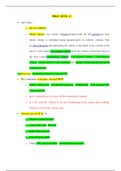PALS QUIZ 2.
Lab Values
oHR: 60-100BPM
oStroke volume: the volume of blood pumped from the left ventricle per beat.
Stroke volume is calculated using measurements of ventricle volumes from
an echocardiogram and subtracting the volume of the blood in the ventricle at the
end of a beat (called end-systolic volume ) from the volume of blood just prior to
the beat (called end-diastolic volume ). End-Systolic volume – end-Diastolic
volume, volume ejected w each heartbeat, SV: amount of blood pumped from left
ventricle per beat Heart rate: contraction of heart in a min 60-100
HF is indicated: w dyspnea, elevated hBNP ohBNP <100=no HF , 100-300 HF is present , >300mild HF, >600 moderate HF ,
>900 severe HF
oquiz1; hypokalemia can cause shallow respiration, dyspnea
oQ 2. Pt with HF, refused to eat and complaining of her nausea and vomiting.
What do you do first? Assess vitals
Nursing care for HF pt : 10
oMonitor weight and I&O
oAssess vital signs: BP, SO2
oHigh fowler position
oRest until pt is stable
oCheck ABG and electrolytes > potassium if use diuretics oConserve energy during care and ADLs oEmotional support oAdmin prescribed O2/ 2L
oAssess med toxicity > digoxin toxicity: oMaintain dietary restrictio n fluid and sodium restriction
Right sided HF Cause:
oinadequate right cardiac output o systemic venous congestion operipheral edema
Risk factors RHF
oLeft sided HF
oRight ventricular MI
oPulmonary problems > COPD & pulmonary fibrosis
Expected findings: Q 3select all oJVD, oascending dependent edema (leg, ankle, sacrum), oWeight gain
oTachypnea due to respiratory distress, opersistent cough, oorthopnea
opolyuria at rest nocturia, oabnormal abdominal distension (ascites) onausea, anorexia, ofatigue, weakness, ohepatomegaly: liver enlargement and tenderness
cause:
opulmonary congestion : dyspnea, cough, bibasilar crackle. Q4
oFrothy sputum > blood tinged
oAltered mental status
oSymptoms of Organ failure such as oliguria Cardiogenic shock:
oSerious complication of pump failure oAfter heart attack
oOften fetal if it is not treated immediately
o following MI o injury to greater than 40% of left ventricle Findings:
oTachycardia, ohypotension, oinadequate urinary output ,
o altered level of consciousness , orespiratory distress, ocrackle, otachypnea, ocool, clammy skin, odecreased peripheral pulses ,
o chest pain
Assess:
o breath sound, crackle and wheezing, heart sounds ,
Monitor:
ocontinuous hemodynamic oAdmin O2
Admin IV:
o morphine, odiuretic, onitroglycerin to decrease preload
o vasopressors opositive inotropes to increase cardiac output and maintain organ perfusion Acute pulmonary edema : olife-threatening medical emergency
orespiratory distress and decrease venous return
Findings: oanxiety, otachycardia,




